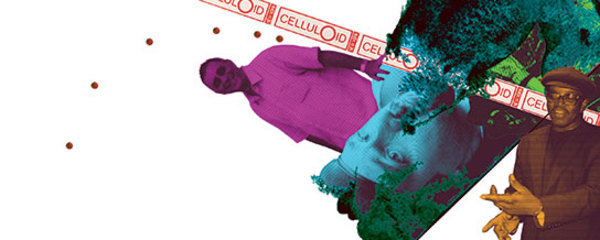Celluloid Records: Change The Beat
If you were to travel back in time to the early ’80s, you’d find a […]
Celluloid Records: Change The Beat
If you were to travel back in time to the early ’80s, you’d find a […]

If you were to travel back in time to the early ’80s, you’d find a vastly different musical landscape. Though the disco era was in full swing and funk’s motherlode was still fertile, album-oriented rock ruled the roost. Alternative rock and electronic music were still in their fledgling stages, R&B had settled into a safe, comfortable groove, world music was the province of folk-loving hippies, and hip-hop had yet to explode across mainstream America’s consciousness.
It was against that canvas that Celluloid Records spray-painted its musical collages. Over its 16-year history, the label would release approximately 100 albums, about 700-800 songs. And though its biggest-selling single–Time Zone’s “World Destruction”–moved an impressive, but not earth-shattering, 70,000 units, all of the label’s avant-garde efforts proved to be a highly influential, if not seminal, factor on the socio-cultural-musical aesthetic that defined the ’90s and beyond.
“Our whole concept,” explains Celluloid’s CEO John Matarazzo, “was to be ahead of the curve. Not so far ahead that people were like, ‘That’s just weird, come back in 10 years,’ but ahead enough so that people were like, ‘Hey, that’s interesting, we didn’t think about that.'”
Enlisting eclectic hipster Bill Laswell as an in-house producer, Celluloid–which maintained offices in Paris and NYC–jumped into the urban music playground at a time when the Afro-futurism–as envisioned by Afrika Bambaataa & SoulSonic Force’s “Planet Rock”–had yet to be grounded by bling-bling materialism and ultraviolent gangsta clichés. The label put graffiti artists together with punk bands, electrified traditional African music, matched bilingual raps with futuristic electro-funk, and helped to establish sample-based music and turntablism as art forms. Though some of the now-defunct label’s catalog is available through digital download on eMusic and iTunes, two discs’ worth of definitive singles have resurfaced on German import Collision as The Celluloid Years.
The set begins with “Escapades of Futura 2000,” which featured The Clash backing Futura, the infamous aerosol abstractionist. Matarazzo says the song symbolized “the idea of blending things that you think just wouldn’t go together… it was special for us, because it represented where we thought things were gonna be going.” After subsequent Aerosmith-Run DMC and P.E.-Anthrax collaborations popularized the rap-rock concept, Matarazzo recalls, “All of a sudden, people were saying, ‘Yeah, that’s a cool idea.’ For me, that’s what really made it, the fact that we could influence people that way.”
Another influential single was Deadline’s “Makossa Rock,” a blueprint for the genre-bending multiculturalisms of today. With a wild, divergent groove built around a driving bassline and electronic snare hit–over which saxophones, trebly synths, syncopated percussion (from West African multi-instrumentalist Foday Musa Suso), bluesy harmonicas, and sampled soundbites swirl for a stamina-testing 10 minutes and 52 seconds–”Makossa Rock” sounded like the African diaspora itself, united through technology and rhythm. “We put people from all kinds of different genres on that record,” Matarazzo says. “That was one of the first records to come out at that time that was like a hybrid between pop music and traditional music from other countries.”
Further globally minded efforts followed; Cameroonian saxophonist Manu Dibango passed through Celluloid’s NYC studios long enough to record two albums and several 12″s. “Pata Piya” and “Abele Dance,” both included on The Celluloid Years, point the listener toward where world music is presently: clubby and electronic, yet still infused with traditional elements.
The ominous “World Destruction” brought together hip-hop legend Bambaataa (who also recorded “The Wildstyle” and “Zulu Groove” for the label) with punk icon John Lydon. “It was an experiment. We thought, ‘This might be cool, this might be a disaster,'” Matarazzo says. “But it worked out great.” The song’s mention of a fiery apocalypse seems especially ominous today. “At the time we put it out, it was kind of a warning. But now, people look at it and go, ‘Hey, it really happened.’ It’s amazing. After 9/11, it was just like, ‘Wow, it’s prophetic.'”
Prophetic in a different way was “Change the Beat,” featuring future Yo! MTV Raps host Fab 5 Freddy and French femme fatale B-Side. Their bilingual rhymes were innovative, but the song will always be remembered for its vocodered sample–“Ohh, this stuff is really fresh,” one of turntablism’s most-scratched phrases. “That was amazing,” Matarazzo says. “You just couldn’t stop it. That was all over the place.”
Today, Celluloid’s legacy echoes in clubs everywhere, yet Matarazzo insists he doesn’t have time to look back. “What’s gonna start happening is, we’re gonna see more and more fragmentation in music,” he says. “The Internet is making that really possible, because the distribution channels are starting to break wide open. The old idea of mass merchandising is kinda ancient history. I think it’s kind of dead. You’re not gonna have one artist you’re gonna sell to half a billion people. You’re gonna have hundreds of artists and you’re gonna sell to maybe 10 or 20, 000 people. And the real challenge is gonna be to find the ones who can really cross over and come into a broader market.”
Chances are, Matarazzo’s speculation is spot-on. After all, he’s already predicted the future once.

